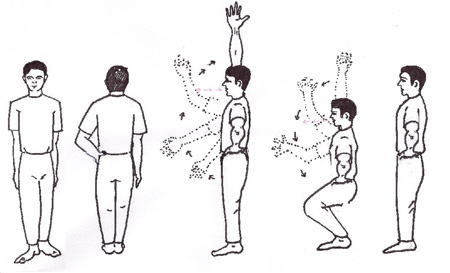Insomnia Chinese Qi-gong Practices
- Mindful exercise to promote sleep
- Internal strength calming qi-gong
- Qi-gong before sleep
- Heaven and earth vitality qi-gong
Mental factor plays an important role for insomnia development, it is not uncommon to be disturbed by daily chores or emotional distress, preventing us from a restful sleep. Chinese qi-gong involves coordination of posture / movements (also known as form or frame), breathing techniques and mental focusing, that aim at integrating and cleansing the body and mind. Regular qi-gong practice promotes health, prevents disease and develops personal potential.

There are different forms of qi-gong exercise to choose from, each of them has its own purpose and focus, appropriate selection according to individual need is important. Moreover, qi-gong training has individual differences, some practitioners can obtain benefits from certain exercises, but the others may not. For beginners, it is better to find a qi-gong master and follow the guidance to practice, this can avoid the undesirable qi-gong reactions.
Mindful exercise to promote sleep
- Preparation: lie on your back, place the arms and legs in the sides, and regulate the breath evenly.
- Operation: close the eyes and let go of the thoughts in the mind, take the midpoint between the eyebrows as the focal spot of your meditation and give it your full attention, at first there will be a sinking feeling experienced on it. If disturbing thoughts intrude, just ignore them, continuously and firmly bring your mind back to the focal point. Gradually, the mind will become peaceful, the distracting thoughts will no longer come, and a hazy state of the brain will appear, which lead to fall asleep naturally.
Internal strength calming qi-gong
- Lay on your back with feet slightly apart, hands by the sides, and palms turned downward;
- Look ahead for a while, then focus between the eyebrows, then slowly look downward to the nose, then to the lower abdomen;
- Close the eyes and mouth, raise the tongue against the hard palate, take deep breaths in and out through the nose;
- While exhaling, imagine that the lower abdomen is filled with qi (vital energy), which spreads all through the body and finally release through the skin pores to the surroundings.
- Take deep breaths 24 times.
Qi-gong before sleep
- Preparation: lie on your back, cup your palms under your belly button, put the left foot over the right foot. Raise the tongue against the hard palate, slightly open your eyes. Relax the whole body.
- Breathing: take three deep abdominal breaths first, and then return to slow normal breathing. Inhale slowly to fill your lower belly first, and then fill your stomach area, follow by the chest and the lungs; hold for a few seconds and begin to exhale; empty the very bottom of your lungs first, then the middle and finally the top. Do the inhaling and exhaling in a peaceful manner, and gradually extend the time of each breath cycle.
- Mental exercise: let go of the thoughts in the mind first, mentally repeat the thought of "I am carefree, I have a light-hearted mood, I look graceful, my body is floating, I am going to sleep."
Heaven and earth vitality qi-gong
- Stand still and place the right foot forward and kick the right heel with the left foot;
- Put the left hand on the waist and with elbow bowing outward; the right arm hangs down naturally;
- Keep the mouth closed, raise the tongue against the hard palate, open the eyes slightly, and then take deep breaths in and out through the nose;
- Stand up straight, let go of the thoughts and focus on the movements only;
- Raise the right arm slowly yet effortlessly while slowly inhale as deep as possible, image that you are a wooden board floating in the water;
- When the right arm is above the head, stretch out the fingers;
- Turn the hand to other side, let the arm slowly downward to draw a semi-circle, and bend the knees gradually, meanwhile slowly exhale as much as possible.
- Stand up again and inhale slowly to the starting position;
- Repeat the above 8 times more.
- Change to the other side and do again.



